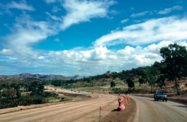The transport networks serving Papua New Guinea (PNG) are set to receive a $1bn overhaul as the country moves to install the infrastructure needed for the next phase of its economic development.
The billion-dollar funding, which was allocated to the Department of Works (DoW) in the 2014 budget, will finance a broad range of projects. Highways and upgrades of urban centres will be prioritised, together with infrastructure to support planned strategic hubs and improve connectivity. The government is looking to develop Port Moresby for business ventures, while Lae and Mt Hagen will be expanded to accommodate industry and mining initiatives, respectively.
On the move
A rapid rise in the number of cars and trucks has highlighted the road infrastructure gap. Annual sales of vehicles from registered garages rose by 72% between 2009 and 2012 to reach 10,503 units, the PNG Motor Traders Association told OBG. Moreover, this figure could well under-estimate the number of additional vehicles on the road, as it does not include undocumented private sales and a growing number of imported second-hand cars.
The vast majority of transactions were for commercial vehicles, which at 25,352 units accounted for 77% of overall sales between 2009 and 2012, followed by light trucks (10%), heavy duty trucks (7%) and passenger vehicles (6%). Growth over the three-year period was most rapid in heavy duty trucks (147%) and passenger cars (77%), although from a smaller base than commercial vehicles.
About a quarter of sales were in PNG’s second city of Lae, located at the start of the 700-km Highlands Highway. The country’s primary roadway, the Highlands Highway links Lae to Mt Hagen and liquefied natural gas (LNG) operations and is proving to be a major challenge for drivers. Despite the priority tag, remedial work on the roadway will take several years to complete.
Vehicle sales are expected to rise further in line with the economy. The Asia Pacific Economic Cooperation Forum projects vehicle ownership to increase from 10:1000 in 2010 to 35:1000 by 2035. It also forecasts annual growth of between 2% and 3% across the transport sector over the same period.
In the more immediate term, transport’s contribution to GDP is expected to rise more rapidly, with the government projecting a 6% increase each year up to 2017, according to the latest budget. While completion of construction work on the PNG-LNG project could put a damper on growth in certain segments of the sector – freight activity is expected to slow, for example – demand from other areas of the economy, such as industry and mining, is set to accelerate.
Fuelling growth
The poor conditions of PNG’s roads have burdened the country with some of the highest cargo transportation rates in the world, estimated at $0.35 per km.
Rising fuel costs, exacerbated by the increasing reliance on imports, is also causing concern. PNG’s sole 30,000 barrel per day refinery at Napa Napa, outside Port Moresby, is equipped to produce only Euro3 standard fuel, which is fast becoming obsolete and is incompatible with modern engines due to its higher sulphur content.
The plant was built by Chevron in Alaska in 1963. It was dismantled, refurbished and transferred to Port Moresby in 2004, although upgrades to the refinery have been few. With domestic oil production on the decline, vehicle owners have found themselves bearing the brunt of fuel import costs.
Higher fuel prices have already weighed on the services industry, particularly tourism, through demand spikes caused by the PNG-LNG project. With national fuel transportation largely limited to ships, outlying centres can expect to pay 20% more for fuel, according to research conducted by the industry watchdog the Independent Consumer & Competition Commission in 2011. Demand for fuel is likely to continue its upward trend, on the back of electricity consumption growth, estimated at 10% per year. Much of PNG’s electricity is still powered by diesel generators, particularly in rural areas.
Follow Oxford Business Group on Facebook, Google+ and Twitter for all the latest Economic News Updates. Or register to receive updates via email.

